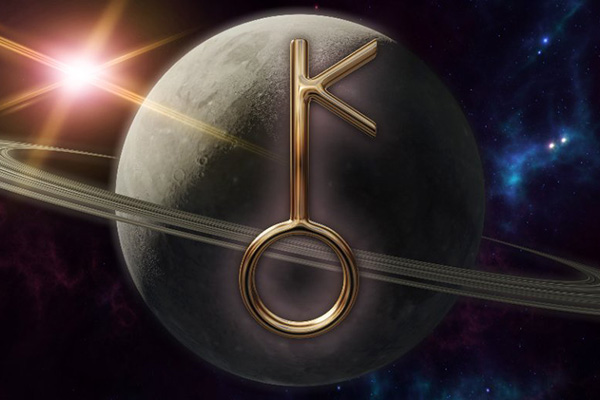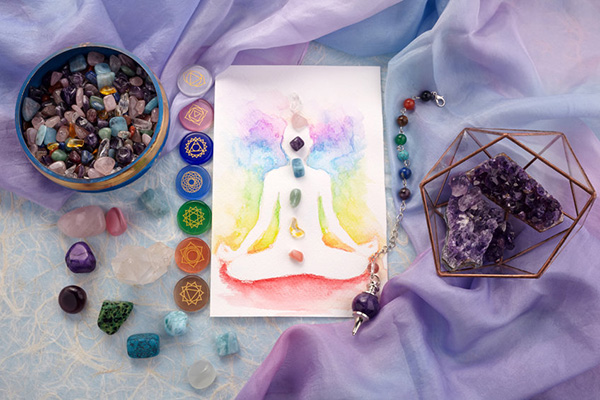Chiron Retrograde Is An Opportunity For Deep Healing
 A lesser-known celestial body to watch if one is metaphysically inclined is the planet-like asteroid or comet known as Chiron, which orbits between the planets Saturn and Uranus. It is named after the wise centaur in Greek mythology who could heal others, but not himself, and is associated with the archetype of the ‘wounded healer.’
A lesser-known celestial body to watch if one is metaphysically inclined is the planet-like asteroid or comet known as Chiron, which orbits between the planets Saturn and Uranus. It is named after the wise centaur in Greek mythology who could heal others, but not himself, and is associated with the archetype of the ‘wounded healer.’
Chiron went retrograde recently on July 19th and its reverse trajectory will last until December 23rd, 2022. This astrological event will challenge us, as Chiron symbolizes the unhealed pain and unresolved past traumas we still carry within. It represents our deepest, core wound and our efforts to heal that wound. The good news is, despite a retrograde cycle bringing challenge, it also bring opportunity for expansion and growth.
Chiron is currently in the fiery, action-oriented sign of Aries where it will remain until the year 2026. This is a difficult placement, because Chiron is all about deep introspection, delicate shadow work and patiently working towards the healing of old wounds, while Aries has little patience in such matters and just wants to ‘get on with it.’
You may feel tempted to rush into the core of your pain and trauma due to this retrograde, but be sensible instead and take a step back. This retrograde period does offer a powerful opportunity for working on inner healing and forgiveness, but take a measured approach and do not foolishly rush in where angels may fear to tread. Give yourself permission to honor slow, steady processing, healing and growth. Healing is like a seed we plant; it takes time for an acorn to grow into an oak tree.
If you find your temper and emotions flaring, remember to breathe, use mantras, and positively visualize your outcome. New growth takes place after a wildfire (Aries) and this is an excellent time to start anew, while overcoming old traumas.
Letting Go Is The Key To Past Life Encounters
 In my psychic readings over the years, I have had many of my clients around the world asking about a special person in their lives. Often the thoughts and feeling they experience with this person are so real, and the connection feels very strong right away.
In my psychic readings over the years, I have had many of my clients around the world asking about a special person in their lives. Often the thoughts and feeling they experience with this person are so real, and the connection feels very strong right away.
The way they explain the feeling to me is that they feel like they have known that person their whole life. If they have just met very recently, and feel this kind of connection, there is often a past life connection or soul agreement. Once you make this kind of connection with someone then you have a fair chance to see where the relationship leads to.
Previous relationships that ended bad, because there was no lasting connection, can have a negative influence on soulmate connections from past lives. Many of us unfortunately want to hold on to such bad learning experiences.
When we are unwilling to let go it is often because we are scared to be hurt again. Then we have someone special enter our lives from a past life connection and we sometimes make it hard for this new person, while they really are not the one to blame for all the pain we experienced in the past with others.
Letting go of the past, and forgiving and moving on, seem so hard to so many people, but it can be so easy when there is someone special in your life to have new beginning with.
Our past lives experience also go beyond meeting someone new. One good example is visiting a location that seem familiar to you. Our past lives, like our dreams, are mystical glimpses into other worlds. We may not always know why we see what we see, but when we do it’s an enlightening look into a past we once lived that offers us personal growth and opportunity for healing.
Crystal Energy Work For Prosperity
 In these difficult times, we are all more budget-conscious, and for good reason. There is fortunately much we can do energetically to improve our finances. If it’s been a while since you worked with your crystals, and you find yourself financially struggling, this is an excellent time to revisit this work. Using the right types of crystals can help you grow and attract this kind of energy.
In these difficult times, we are all more budget-conscious, and for good reason. There is fortunately much we can do energetically to improve our finances. If it’s been a while since you worked with your crystals, and you find yourself financially struggling, this is an excellent time to revisit this work. Using the right types of crystals can help you grow and attract this kind of energy.
But instead of merely wanting more money, think about the concept of prosperity: the state of being successful and thriving with complete economic well-being.
Prosperity crystals have colors associated with wealth: green, gold, and clear. The beauty and power of green stones such as jade, amazonite, aventurine, and peridot are known for their ability to attract wealth. The same is true for crystals and stones in shades of gold (citrine, tiger’s eye, amber), as well as pyrite, or fool’s gold. And clear quartz, one of the most versatile crystals of all, sparkles like a diamond and further magnifies the traits of the other prosperity stones.
The best way to use your favorite prosperity crystals and stones depends on your intention. If you have entered a lottery or lucky draw, for example, you can simply carry a prosperity crystal or two in your pocket. An entrepreneur or business executive can wear a stylish piece of jewelry with their favorite prosperity stone to grow a new business venture.
Prosperity energy doesn’t have to be all about money only. Think of good fortune when making important deals, or a sudden flash of inspiration for a viable creative project. This is one of the key secrets many people struggle to grasp with prosperity: it is not merely material wealth!
Find Your Calm In Crystals
 It’s been a stressful couple of years for everyone, and stress-relief can be hard to accomplish. Stress, if untreated, can lead to a host of physical and emotional symptoms. But dealing with the stress of everyday life can be made easier with the right crystals in your spiritual practice.
It’s been a stressful couple of years for everyone, and stress-relief can be hard to accomplish. Stress, if untreated, can lead to a host of physical and emotional symptoms. But dealing with the stress of everyday life can be made easier with the right crystals in your spiritual practice.
When starting to work with these amazing crystals and stones, consider this: what causes stress in your life in the first place? Usually, it happens when we feel out of control and our energies aren’t properly centered and grounded. Earth-toned crystals such as smoke quartz (associated with the Earth element for stability) and tourmaline (release of negative energies) bring us to a baseline of positive energies to de-stress.
Soothing colored colors like blue (chrysocolla, aquamarine, lapis lazuli, larimar), violet (rhodonite, amethyst, tanzberry quartz, lepidolite), and white and grey (scolecite, howlite, agate) are traditionally associated with tranquillity and serenity. The cooler hues reflect the elements of water, or emotions, and air, our thoughts.
If you use some of these stress-relieving crystals in your meditations, imagine them help tame the runaway thoughts or feelings which cause so much turmoil. In the chakras, these are the Crown Chakra (thoughts) and Third Eye Chakra (emotions, psychic intuition), which are also represented by blues and purples.
Sometimes stress is less generalized and more related to one specific area in life. Which area is this for you? Knowing will help select the best crystal for your needs. If you’re overcome with panic attacks, amethyst (a well-known stress reliever) or blue sodalite (the Stone of Peace) are good choices.
Perhaps you’re having difficulty with communication at work or in a relationship, so blue lace agate (opening channels) or lapis lazuli (confidence) will work better for you. The possibilities for your crystals are endless: you might want to keep them with you in your pocket, in a necklace or bracelet, or create a special arrangement in your home or office.
Using Crystals To Reduce Stress And Anxiety
 We all live with various amounts of stress in our daily life, and the last few years have been especially trying. But stress doesn’t have to be overwhelming for the spiritually conscious person. Apart from meditation and similar spiritual practices, an especially powerful ally can also be found in the use of various types of crystals. Whether you choose to keep them in your pocket, wear them as jewelry, or use them in your energy work, there is a crystal for everyone based on your own needs and affinities.
We all live with various amounts of stress in our daily life, and the last few years have been especially trying. But stress doesn’t have to be overwhelming for the spiritually conscious person. Apart from meditation and similar spiritual practices, an especially powerful ally can also be found in the use of various types of crystals. Whether you choose to keep them in your pocket, wear them as jewelry, or use them in your energy work, there is a crystal for everyone based on your own needs and affinities.
Among the most popular stones for crystal therapy and relieving stress is quartz. It’s easy to obtain and comes in different types. Clear quartz (what many people might think of when they visualize a crystal) offers clarity and vision when things seem muddled. Like a prism, it also brings out the hidden qualities of other crystals.
But quartz is also available in other colors to support us with life’s many challenges, such as rose (pink) to settle turbulent emotions and find solace when broken-hearted, and smoky (grey) to bolster our courage.
Another popular clear stone is citrine. As its name suggests, it is orange or yellow in color. Carrying a citrine stone is like having a drop of sunlight in your pocket; it wards off the gloom on even the worst ‘rainy,’ stressful day.
Blue agate (available in different shades) is useful when clearing up stress related to miscommunication. It is a recommended to keep one at the office or take it with you to school.
Almost as popular as quartz, amethyst (opaque purple) is a go-to if you tend to suffer from nervousness, anxiety, or panic attacks. It can be used while reciting mantras to invoke deeper serenity and calm.
Make Your Own Magical Moon Water
 The Moon, our closest celestial body, is strongly associated with the element of water. One way we can harness its powerful energy is by making moon water. Moon water is a powerful tool for energy cleansing and balance, and for strengthening spiritual connection.
The Moon, our closest celestial body, is strongly associated with the element of water. One way we can harness its powerful energy is by making moon water. Moon water is a powerful tool for energy cleansing and balance, and for strengthening spiritual connection.
The energy charging of moon water can be done at any time, but it is most ideal with the Full Moon. All you need is distilled or fresh water, a container, and a strong sense of intent.
Choosing the right container for your moon water is key. Think about what you plan to do with it: bathing, drinking, watering plants. If you are going to leave the container outside and overnight, consider a mesh or other permeable covering or lid so nothing except moonlight can get inside.
You can also include lunar affinity crystals, such as moonstone, clear quartz, or opal in the making of moon water. You can leave it in the container where it will receive an optimal amount of moonlight, then retrieve it in the morning.
Also, consider the astrological placement of the moon when making your moon water. For example, if you are setting an intention for extra insight and focus in your business or career, then a Full Moon in hardworking Capricorn is an ideal time to make some moon drinking water for the office.
As with any spiritual practice or manifesting ritual, stating your intentions clearly and firmly beforehand is vital. Remember to also extend gratitude to the Moon for her power and positive energies.
Let Your Authentic Self Shine
 Most people at some point change something about ourselves in the hope of being better liked or accepted by others. Whether it’s a group of friends, a potential romantic partner, or the manager at work, there is constant pressure to conform and fit in. But in the long run, does this help? The truth is: it really doesn’t.
Most people at some point change something about ourselves in the hope of being better liked or accepted by others. Whether it’s a group of friends, a potential romantic partner, or the manager at work, there is constant pressure to conform and fit in. But in the long run, does this help? The truth is: it really doesn’t.
The notion of simply being your authentic self is challenging in an era where everyone seems to be seeking approval and attention. Therefore, the authentic self or the true version of our soul is something one hardly sees in the digital era of social media, influencers, likes, and followers.
However, we may think that a person we see online is someone others won’t like. Maybe our internal critic sees that person as ‘too much’ of something or ‘not enough’ of another. But we are often mistaken, as someone being true to themselves and keeping it real is what most people are spontaneously drawn to.
You might feel like you’re the only strange person at work, or the black sheep of your family, but you’re not the only one. There are thousands of ‘odd’ people out there right now with the same doubts as you!
The old saying ‘there’s a lid for every pot’ is always good to keep in mind. Your authentic self is just what someone else has been looking for. If you feel you don’t fit in with the crowd, take a step back and ask yourself whether you truly want to be part of it anyway? Knowing your true value and finding the things most important to you, will help determine who you want to surround yourself with.
It’s also important to set healthy boundaries. If you feel peer pressured into joining a group, or liking something simply to fit in, ask yourself if this is true to your core. Does it resonate with your authentic self?
